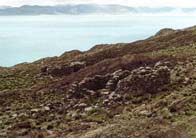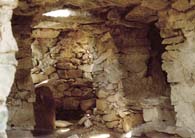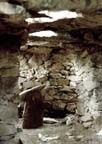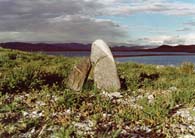 Click here for Map (125 K) |
Until I began systematic exploration of Changthang, more than ten years ago, little was known about the character of its ancient civilization. In that time, I have charted dozens of sites spread over 400, 000 square kilometers, documenting the existence of the legendary Zhang zhung kingdom. Zhang zhung, according to classical Tibetan texts, was a powerful nation which dominated the Tibetan plateau before being conquered by the central Tibetan Pugyal (sPu rgyal) dynasty in the 7th or 8th century (2). Textual sources aside, there was little evidence for Zhang zhung before I began my work.
Earlier in the century, Western scholars did some pioneering work as have Chinese archaeologists more recently. In the 1920's, the Central Asiatic Expedition of George Roerich uncovered megalithic sites and graves in the Changthang, which appeared to be typologically related to the Bronze Age and Iron Age barrows of Eurasia (3). In the 1940's, the renowned tibetologist Professor Tucci advanced archaeology further by discovering the remains of pre-Buddhist temples at Khyung Lung Ngulkhar (Khyung lung dngul mkhar)(4). Since the 1970's, Chinese scientists have discovered Neolithic tools and paintings at a variety of places in the Changthang (5). Work continues and, on the 19th of September, 1998, the Lhasa branch of the Xinhua news agency announced that the Chinese had uncovered fortresses, settlements and wall paintings in Ngari province at an elevation of 4000 meters.
|
|
The remaining houses at Black Rock are in successively poorer states of preservation. Save for one exception, they appear to have been built without windows. Each of the houses had a walled courtyard leading to the entrance of the house. The entrances range from 1.1 meters to 1.5 meters in height. All entrances face east, traditionally the preferred orientation for the doors of the shepherd's yak hair tents. Some of the houses were divided into two or more units each consisting of small irregular shaped rooms, typically around 1.8 meters in length. The largest structure at Black Rock is situated on the Lower Terrace. Its rear wall extends for 50 meters and appears to have been an integrated multi-roomed complex. Unfortunately, surface remains have been largely obliterated, in part, because some of its stones were borrowed to construct corrals.
|
|
Footnotes:
(1) John Vincent Bellezza has published a number of scholarly works detailing his research and discoveries in the Changthang. A major work "Divine Dyads: Ancient Civilization in Tibet" (Library of Tibetan Works and Archives: 1997) explicates the cultural history and archaeology of Namtso (gNam mtsho) and Dangra Yumtso (Dang ra g.yu mtsho). His monographs and articles include "Doring Revisited" (Himal: May-June, 1995);"A Preliminary Archaeological Study of Da rog mtsho" (LTWA: to appear in the Spring 1999 volume of The Tibet Journal) and "Notes on Some Unusual Symbols" (East West: Summer 1998). In 1999, Bellezza is also publishing a monograph on cave paintings he has discovered in the Changthang. return to text (2) For references to Zhang zhung see works such as C. Beckwith's "The Tibetan Empire in Central Asia" (Princeton University Presss: 1987); Namkhai Norbu's "Drung, Deu and Bön" (LTWA: 1995); and Samten Karmay's "The Treasury of Good Sayings: A Tibetan History of Bon" (Oxford University Press: 1972). A few important references to the culture and political history of Zhang zhung in Tibetan works are "Old Tibet Chronicle", "'Bel gtam lung snying", "Zhang zhung ju thig", "bsTan byung ke ta ka'i 'phreng ba" "Byams ma", and "Rig 'dzin rig pa'i thugs rgyud". return to text (3) See George Roerich's "Izbrannye Trudy" (Collected Works) (Hayka: 1967). return to text (4) See G. Tucci's "Transhimalaya" (Vikas:1973). return to text (5) For data on Chinese archaeological discoveries in the Changthang see works such as Anne Chayet's "Art et Archéologie du Tibet" (Picard: 1994); Sonam Wangdu's "Art of Tibetan Rock Paintings" (Sichuan People's Publishing House: 1994); ( "Hu Xu Tru's "Xizang Kao Ku Da Gao" (Xizang Jenmae Tru Ban Zhu: 1973); and Li Yongxian's "New Discoveries in Tibet" (China's Tibet, vol. 6, 1995). return to text (6) General attributions aside the Mon or Monpa refers specifically to a people of eastern Bhutan, western Arunachal Pradesh and adjoining areas of Tibet. In epic literature the Monpa are an ancient people who were the enemy of the Tibetan Hero Ling Gesar. return to text (7) For a through explication of the dyadic functions of the important mountain and lakes in the Changthang see Bellezza's "Divine Dyads: Ancient Civilization in Tibet". return to text (8) Refer to Huang Ci-xuan and Liang Yu-lian's paper in "Geological and Ecological Studies of Qinghai-Xizang Plateau", vol. 1 (Beijing Science Press: 1981). return to text (9) Stelae called doring (rdo ring) in Tibetan are erected for various functions including: 1) inscribed edicts of ancient kings; 2) shrines for indigenous deities; 3) marking the foundation of houses and religious edifices; 4) funerary monuments; and 5) structural features such as corral walls. return to text (10)Sacred mountains in Tibet are often referred to as pillar of the sky (gnam gyi ka ba) underscoring their central importance in indigenous spatial conceptions. return to text (11) There are numerous works which deal with the ancient Central Asians and their burial customs. It will suffice to mention just a few such as Boris Piotrovsky's "Scythian Art" (Phaidon: 1987); "From the Land of the Scythians" (The Metropolitan Museum of Art, new York: 1975); and "Nomads of Eurasia" (Natural History Museum, Los Angeles: 1989). return to text
© Copyright 1998 John Vincent Bellezza |














